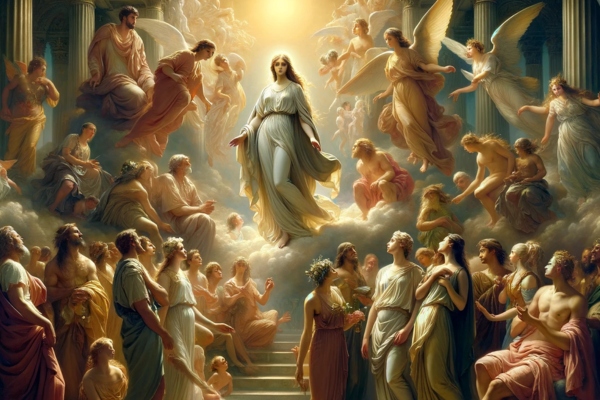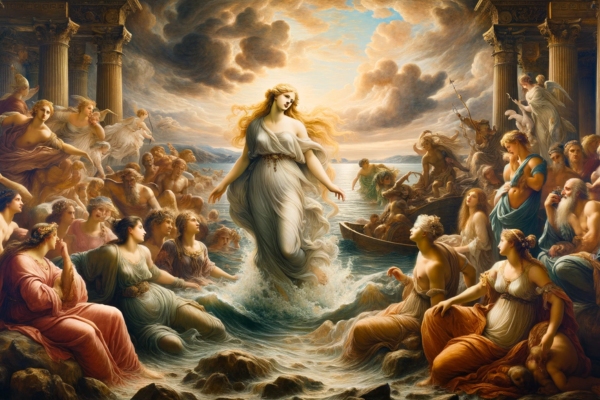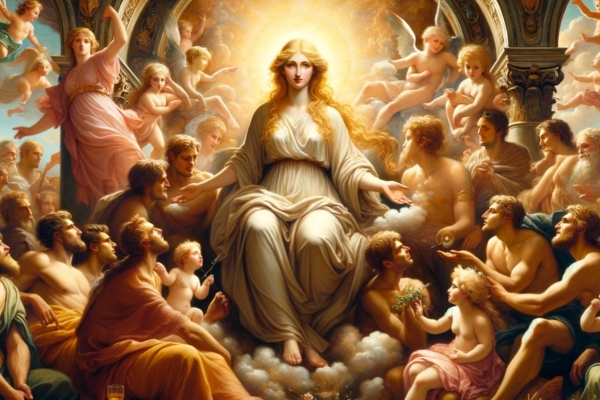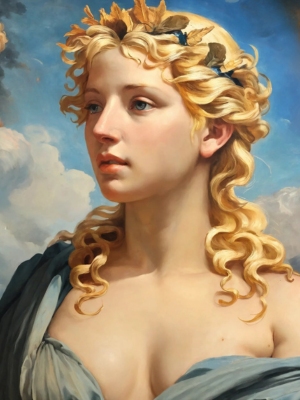Home » Goddess Venus: Roman Deity of Love, Beauty, Fertility & More
Goddess Venus: Roman Deity of Love, Beauty, Fertility & More
You may already know that Venus is the Goddess of love and beauty, but do you know what her personality was like? Or what symbols she’s associated with and why?
Or what influence she had had on Western society?
In this blog post, we’ll dive deeper into the heart of her mythology to explore all the important facts about Venus Goddess of love.
We’ll start by unraveling her origins. Then, we’ll navigate through the myths that spotlight her pivotal role in shaping Roman culture.
We’ll also examine her personality and characteristics based on the mythical stories told about her. And you’ll see all the divine powers she wielded.
Let’s explore all of these elements of the Goddess Venus and see how she’s influenced culture throughout history.
Who is Goddess Venus?

Goddess Venus is the ancient Roman deity of love, beauty, and fertility.
She had control of these realms just like her Greek equivalent Aphrodite.
She was also known for her association with desire, passion, and prosperity. So she plays a crucial role in various Roman myths and stories.
Venus is often depicted as a sign of love’s power to conquer all obstacles. Her presence signifies harmony and unity among people.
And her representation as the goddess of beauty highlights her connection to aesthetics, grace, and physical attractiveness.
The belief in her ability to inspire affection played a crucial role in how relationships were perceived by the Romans.
People of ancient Rome believed she had this special power to spark love and make connections between people.
For many, her favor was considered essential for a harmonious and affectionate bond with another person.
Beyond her role in love, she was seen as a bringer of prosperity and success, both in personal wealth and in the broader sense of agricultural bounty and military victory.
As the goddess of love, Venus was an important part of Roman mythology, being associated with all things romantic and beautiful, as well as being linked to the success and well-being of the Roman people.
Origin Story of Venus

The name Venus comes from the Latin word for love.
The name itself reflects the attributes and special qualities that she embodied in mythology.
How was the Goddess Venus born or created?
She actually didn’t have her own origin story.
Her creation is linked with Aphrodite because the Romans inherited her myth from the Greeks, celebrating her as a central figure in their own pantheon.
According to the ancient myth taken from the Greek version, she was born fully grown from the froth of the sea, which came into being from the discarded genitals of the sky god Caelus (known as Uranus in Greek mythology).
In Roman mythology, her birth is famously described by the Roman poet Publius Vergilius Maro, known as Virgil, in his epic work “Aeneid.”
Additionally, her birth and mythology are elaborated on by other ancient writers, including the Roman poet Ovid in his work “Metamorphoses,” where he delves into the myths and stories of the gods, including hers, who was born from the sea foam.
Venus’s birth from the sea links her to aspects of fertility, renewal, and the life-giving forces of water.
How Goddess Venus Influenced Western Society
From art to language, Venus has left a lasting impact on Western culture.
Her influence is everywhere.
Renaissance art adored her, leading to timeless masterpieces like Botticelli’s “The Birth of Venus.” These artworks celebrated beauty and humanism, core values of the era.
Her legacy isn’t just in art.
The goddess has also inspired fashion and literature, showing her timeless appeal.
Her myths are retold in countless ways, showing the enduring fascination with themes of love and beauty.
The influence of Goddess Venus on Western society is a testament to how ancient myths can shape and enrich contemporary life, reminding us of the power that love and beauty possess.
Her impact also extends to architecture.
Buildings, structures, and gardens designed with her in mind capture her essence through graceful forms and romantic landscapes.
Her effect is like a never-ending river that flows through the heart of a great city.
Just as the river shapes the city’s landscape, guiding its development and nurturing its growth, Venus’s ideals of love, beauty, and desire have continuously sculpted Western society’s view of those elements.
Her footprint on the West is a mosaic of art, language, science, and culture.
Venus Goddess Symbol

The above picture shows the main symbol of Goddess Venus.
But she also had a few other objects associated with her that personify all of the things she represented in Roman mythology.
Like sacred animals and flowers.
Here’s a list of the many different symbols linked to her:
1. Mirror: Symbolizes beauty and self-reflection, often depicted with the goddess admiring her own beauty. Because she personified beauty, the mirror is a natural fit as a sign that represents her realm. The mirror serves not only as a testament to her physical allure but also as a deeper symbol of the power of attraction and the reflective nature of love itself, urging us to see the beauty within.
2. Rose: One of the main flowers associated with Venus because it represents love, desire, and romance. Essentially, roses are emblematic of her domain and control over love. The rose’s thorns juxtapose its beauty, suggesting that love can be both enchanting and painful. This flower embodies the complexity of relationships and the dual nature of desire, making it a fitting emblem for the goddess of love.
3. Apple: Linked to the story of the Judgment of Paris, the golden apple symbolizes discord and beauty. This fruit became a powerful token of desire and strife, leading to the infamous Trojan War. Its association with this Roman goddess underscores the potent and sometimes tumultuous effects of beauty and love. And it illustrates how they can lead to conflict and change the course of history.
4. Shell: Reflects her birth from the sea; she is often depicted standing on a shell. This image is iconic, symbolizing her connection to the natural world and her emergence as a force of beauty and fertility. The shell not only signifies her origins but also represents the protective and nurturing aspects of love, highlighting how her influence extends beyond mere attraction to encompass the generative powers of the natural world.
5. Colors: She is often associated with the colors red and pink, symbolizing romance and affection. White, reflecting purity and beauty, is another color frequently linked to her. These colors represent her essence. And they reinforce what areas of mythology she had control over.
6. Dove: This bird is sacred to Venus and represents peace, love, and harmony; doves are frequently connected to her. The gentle cooing of the dove embodies the soft whispers of the heart, serving as a reminder of her nurturing presence in matters of love and the peaceful bonds it fosters, symbolizing the goddess’s gentle touch upon the world, guiding relationships towards harmony.
7. Myrtle: This tree is associated with Venus, as it symbolizes love, beauty, and fertility in Roman mythology. The myrtle’s connection to the goddess highlights its importance in ancient rituals and its role as a symbol of marital fidelity and eternal love. It also represents immortality.
8. Anemone Flower: It symbolizes the transient nature of love and beauty. It’s a flower associated with the relationship and passion she had for Adonis. The fleeting bloom of the anemone reflects the poignant beauty of love’s moments, a testament to the ephemeral nature of physical beauty and the eternal impact of love lost or cherished, embodying the cycles of life and love she oversees.
9. Swan: Another sacred animal of this goddess that symbolizes beauty and grace. It’s often linked to her elegant and serene nature. Swans glide through water with effortless elegance, mirroring her own graceful influence over love and the arts. Their loyalty in pairs symbolizes the ideal of faithful, everlasting love.
10. Venus The Planet: She’s in the stars too, with a planet named after her, symbolizing her brightness and beauty in our night sky. This reflected the ancient Romans’ practice of naming celestial bodies after their deities. The planet was associated with the goddess due to its striking luminosity and beauty, mirroring her attributes of allure and enchantment.
In one way or another, every Venus symbol is connected to her powers and the different realms she ruled over.
Venus Goddess Powers
Here’s a list of all the powers of Goddess Venus:
1. Power over Love and Desire: One of her core abilities is being able to ignite love and desire among gods and mortals alike. She could cause individuals to fall deeply in love with one another or inspire a passionate attraction that could lead to both joyous unions and tragic downfalls. Her son, Cupid, often accompanied her, shooting arrows to kindle love in the hearts of both divine and human beings.
2. Influence over Beauty and Harmony: This is one of those Venus goddess powers that makes her so revered, even today. She had the magical ability to bestow beauty upon individuals and objects, making her a patron deity of artists, beauticians, and lovers of aesthetics. Her influence extended to fostering harmony and grace in the natural world, ensuring that beauty was appreciated and revered in all its forms.
3. Patronage of Fertility and Growth: Beyond love and beauty, she was also associated with fertility and the prosperity of crops and gardens. Her blessings were sought to ensure bountiful harvests and the fruitful growth of plants, tying her to the cycles of nature and the well-being of communities.
4. Victory in Battle: Although primarily known for her softer aspects, she also possessed the power to grant victory in battle. This special feature of her divinity, known as Victrix, was particularly venerated by soldiers and leaders seeking triumph in their military endeavors. Her favor was believed to tip the scales of fortune towards those she supported, highlighting her influence over fate and destiny.
5. Celestial Influence: The special powers of Venus extended to the heavens, with the planet named in her honor reflecting her brightness and beauty in the sky. As the “Morning Star” and “Evening Star,” the goddess influenced navigation and timekeeping, representing the celestial aspect of love and beauty that guided ancient societies.
6. Protection and Patronage: She offered protection and patronage to various aspects of life, including marriages, women, and even the city of Rome itself. Her divine favor was believed to bring peace, prosperity, and divine protection, reinforcing her role as a guardian deity.
7. Transformation and Renewal: Her abilities allowed her to also enact change and transformation, symbolized through myths such as the transformation of her true love Adonis and the rebirth of souls through love. This important power underscores her role in the cycles of life and death, embodying the idea that love can transcend mortal limits.
Her weapons are metaphorical, representing control over love and desire. Her charm, beauty, and persuasive abilities were her true strengths, enabling her to sway others and influence the course of events without the need for physical weapons.
Most of these Venus goddess powers encompass love, beauty, fertility, and prosperity.
Her divine skills have remained a big part of her allure.
Personality and Characteristics of Goddess Venus
Her archetype symbolizes love, beauty, prosperity, and fertility, influencing how Western society perceives all of these elements.
The characteristics of Goddess Venus in Roman mythology show that she was not only the embodiment of love and beauty but also a symbol of fertility, victory, and even diplomacy.
From guiding romantic endeavors to overseeing the growth of gardens and the prosperity of communities, she shaped the minds and behavior of ancient followers.
Her character traits weren’t limited to just benevolence.
She was complex, sometimes displaying a mean streak, especially in myths involving her relationships.
Or when she was competing for attention and honor among gods and mortals. She displayed her rage when Psyche, a mortal, caught the eye of Cupid, her son.
Envious of Psyche’s beauty and the attention she received from her son, the goddess set a series of impossible tasks for Psyche, hoping to doom her.
This story illustrates her darker side, showing how even the goddess of love could be driven by jealousy to seek revenge against those she perceived as rivals.
Her capacity for both unconditional love and fiery passion is one of the most noticeable aspects of her persona.
Venus’s personality is as layered as the petals of the roses that are sacred to her.
Her role in mythology encompasses the two-sided nature of love: its ability to bring joy and harmony, as well as its potential to lead to jealousy and strife.
All of these attributes are part of what has made her an enduring symbol of romance and life all throughout history.
These personality and character traits of Venus embody the full spectrum of human emotions and experiences related to love and relationships.
Venus Roman Goddess Facts
Beyond her iconic status in mythology, she is a figure of intrigue and reverence, embodying the complexity of emotions and natural phenomena.
Here are some interesting facts about Venus the Goddess of Love:
1. Her Greek Counterpart: While she is celebrated in Roman mythology, she is often equated with Aphrodite, her Greek counterpart. Many people believe they are the same thing. But while both deities share attributes of love and beauty, they also have unique stories and aspects in their respective cultures.
2. Born from the Sea: One of the most famous myths about her is the way she was born. According to legend, she arose from the sea foam, fully grown, on a shell, symbolizing her connection to both the beauty and the tumult of the ocean.
3. A Family of Divinities: She was part of the Roman pantheon, linked to other gods and goddesses through intricate family ties. She was the mother of Cupid, the god of love, and through him, influenced the fates of gods and mortals alike in matters of the heart.
4. Her Love Affairs: Her romantic escapades are legendary. Her most notable affair was with Mars, the god of war, showcasing the enthralling contrast between love and conflict. Stories like this one reflect the humanizing of deities, attributing them with passions and vulnerabilities.
5. Protector of Rome: She also played a crucial role as a protector of Rome. She was revered as Venus Genetrix, the mother of the Roman people, emphasizing her importance in Roman state religion and identity.
6. Symbolism and Influence: She has been a symbol of femininity and allure across ages. Her influence extends into art, where she has been a favored subject, epitomizing idealized beauty and harmony. From Botticelli’s famous work about her, to contemporary works, her image inspires artists worldwide.
7. In Astrology: Beyond mythology, she holds significant astrological importance, governing love, beauty, money, and personal values in one’s birth chart. Her position can influence emotional expression and relationship dynamics.
8. A Celestial Namesake: Her legacy reaches into the cosmos, with the second planet from the Sun bearing her name. This bright celestial body, often called the “Morning Star” or “Evening Star,” reflects her association with beauty and love even in the vast expanse of space.
9. Festivals and Celebrations: In ancient Rome, she was celebrated in various festivals, such as the Veneralia, dedicated to her as her Verticordia version, the changer of hearts, and Victrix, the bringer of victory. These celebrations highlight her multifaceted role in Roman society.
10. Her Husband: She was married to Vulcan, the god of fire and blacksmiths. This union, often depicted as tumultuous due to her affairs, highlights themes of contrast and balance between beauty and craftsmanship in mythology.
11. A Symbol of Political Power: Julius Caesar claimed her as his ancestor, specifically her version as Genetrix, to legitimize his rule and connect his lineage to divine favor. This association elevated her status as a guardian of Rome and a symbol of political and familial heritage.
12. Her Vegetation Connection: Although primarily known for love and beauty, she also had affiliations with gardens and vegetation. She was sometimes invoked as Victrix in gardens, embodying growth and fertility alongside her more well-known domains.
These facts about Venus, the goddess of love, weave through the fabric of ancient myths into the modern imagination.
What is the Family Tree of Venus?

Venus, in Roman mythology, has a family tree that ties her to both mortals and gods, emphasizing her divine connections and influence.
Here’s an overview of her family tree:
Husband: Vulcan, as mentioned earlier, is her husband and the god of fire and craftsmanship. Despite this marriage, she had numerous affairs, most notably with Mars, the god of war, with whom she had Cupid and other children according to various myths.
Parents: According to different myths, she was born in various ways. One of the most famous stories, inspired by her Greek counterpart’s origins, claims she was born from the sea foam, making her the daughter of Uranus (the sky) indirectly. In other versions, Jupiter (Zeus in Greek mythology) is considered her father, with Dione sometimes mentioned as her mother in these contexts.
Siblings: If considering Jupiter as her father, her siblings would include Mars (god of war), Minerva (goddess of wisdom), Apollo (god of the sun, music, and prophecy), Diana (goddess of the hunt), and others, as Jupiter had numerous offspring.
Consorts and Lovers: She had several consorts and lovers. Her most famous consort is Vulcan (Hephaestus in Greek mythology), the god of fire and metalworking, to whom she was married. However, she is perhaps best known for her affair with her true lover Mars (Ares in Greek mythology), the god of war.
Children: With Mars, she had several children, including Phobos and Deimos (personifications of fear and terror in Greek mythology), Harmonia (goddess of harmony and concord), and Cupid (Eros in Greek mythology, the god of love). With her husband Vulcan, the mythology is less clear about their offspring, with no widely recognized children between them in Roman myths.
The family tree of Venus reflects her interconnected roles in Roman mythology, bridging elements of love, beauty, war, and harmony.
What Myths Mention Venus?
In Roman mythology, her narrative draws heavily yet distinctively from the tales of her Greek counterpart, albeit with notable divergences.
Here’s a look at some of the most appealing myths Goddess Venus is mentioned in:
Her Birth Story: Perhaps the most iconic tale is her birth. Arising from the sea foam, she was born fully grown, emerging on a shell off the coast of Cyprus. This miraculous birth, symbolizing purity, and natural beauty, has been a favorite subject in art and literature, epitomizing the goddess’s connection to creation and allure.
Marriage to Vulcan: Her marriage to Vulcan, the god of fire and craftsmanship, is a tale of contrasts. Vulcan, known for his unsightly appearance and limping gait, was a stark contrast to her unrivaled beauty. Their union symbolizes the pairing of beauty with skill, highlighting themes of acceptance and the diverse nature of love. Despite her numerous affairs, Vulcan’s enduring love for her and his attempts to please her with his creations reflect the complexities of their divine relationship.
Venus and Mars: The affair between her and Mars, the god of war, is a legendary narrative that showcases the union of opposites—love and conflict. Despite her marriage to Vulcan, the blacksmith god, her liaison with Mars underscores the irresistible pull of desire, leading to a timeless story of love transcending boundaries.
Relationship with Cupid: Many stories highlight the relationship between the goddess and her son, Cupid, the god of love. One such tale involves Cupid’s love for Psyche, a mortal woman whose beauty rivaled that of Venus herself. Jealous of Psyche, she imposed numerous trials on her, each one a testament to the power of love and the trials it must endure. Ultimately, the story celebrates the triumph of love over adversity, with the Roman goddess accepting Psyche into the pantheon as a goddess.
Relationship with Anchises: Another notable myth involving this goddess is her union with Anchises, a mortal Trojan shepherd. She disguised herself as a mortal woman and seduced Anchises and later bore him Aeneas, who would become a hero of the Trojan War and the legendary ancestor of the Romans. This story is crucial in Roman mythology, as it links the divine lineage of this goddess to the founding of Rome, emphasizing her role as both a mother and protector of the Roman people.
Role in “Aeneid”: In Virgil’s epic poem, “Aeneid,” she plays a pivotal role as the mother of Aeneas, guiding and protecting him throughout his journey from Troy to Italy, where he is destined to found Rome. Her divine interventions on behalf of Aeneas highlight her protective nature and her vested interest in the destiny of her descendants and the future glory of Rome.
Through her myths, this charming goddess continues to inspire and motivate.
Her Epithets
Like many other deities, Venus was celebrated with various epithets that captured her multifaceted roles and attributes.
Here’s a few of them:
• Venus Victrix: showcased her as the victor in love and war, illustrating her power to sway battles and hearts.
• Verticordia: highlighted her role as the changer of hearts, protecting chastity and turning hearts towards love.
• Genetrix: emphasized her aspect as the mother and progenitor, linking her to the lineage and prosperity of the Roman people.
• Cloacina: (“the Purifier”) was an aspect of hers that was associated with the purification of the Cloaca Maxima, Rome’s sewage system, symbolizing the cleansing of the spirit.
• Erycina: (“Venus of Eryx”) was named after her worship at the Sicilian temple of Eryx, and was associated with fertility and protection.
• Felix: (“Lucky “) represented the goddess as the bringer of good fortune and happiness.
• Murcia: (“the Myrtle”) linked her to the myrtle plant, which was sacred to her and symbolized love and beauty.
• Obsequens: (“Indulgent or Compliant”) highlighted her willingness to grant the prayers and desires of her devotees.
Each epithet of Venus reflects the diverse ways Romans revered and sought her favor, recognizing her influence in their lives, from love and beauty to their very identity and survival.
Temples and Festivals of Venus
Temples devoted to her were abundant across the vast Roman Empire.
The Temple of Venus Genetrix in Rome stood out as one of the most renowned structures dedicated to her.
The magnificent architecture of these temples symbolized reverence towards the goddess, showcasing intricate designs and grandeur.
People visited these sacred sites to pay homage to her, seeking approval for various aspects of their lives. The presence of such temples highlighted the significance attached to her in Roman culture.
These spaces provided a tranquil environment for followers to connect with their deity.
In Roman culture, festivals dedicated to celebrating love were held in honor of her.
These festivals, filled with joyous celebrations and rituals, aimed to invoke blessings from her for harmonious relationships and enduring love.
During these festive occasions, people would gather at temples or shrines.
They would offer prayers to Venus, as well as sacrifices, or tokens symbolizing their desires for fulfilling romantic relationships guided by the influence of the goddess.
The festivals served as a time for communities to come together in merriment while seeking guidance from the goddess on matters related to the heart.
The atmosphere was one filled with hope for finding true love or strengthening existing bonds under the divine protection of the goddess.
These occasions allowed people to express gratitude and get spiritual help from her.
Conclusion
In our exploration of Venus, Roman goddess of love and beauty, we’ve journeyed through her divine origins.
And we marveled at her powers to inspire affection and harmony, and we recognized her symbols that have transcended centuries.
With her complex personality, she embodies the very nature of love — which is its capacity for both nurturing growth and bringing about envy.
Her myths, rich in drama and emotion, not only entertain us but also offer insight into the human condition.
Venus’s impact on Western society is visible in art, literature, and cultural norms, underscoring her enduring relevance.
She remains a symbol of the eternal quest for beauty, love, and relational harmony.
This comprehensive journey through her realm invites further reflection on her symbolic importance and cultural significance.
The legacy of Goddess Venus is not just in the stories of old but in the way her spirit continues to inspire our understanding of love and beauty today.
FAQs About Venus Goddess of Love
In Roman mythology, she holds a prominent role as the embodiment of various aspects of femininity, love, fertility, and prosperity. She also symbolizes desire and represents an essential force in both personal relationships and societal harmony.
Her mythology dates back to at least the 3rd century BCE. Her worship in Rome likely began in the early stages of Roman history, blending with the mythology of her Greek counterpart, as Romans came into contact with Greek culture. The oldest temple dedicated to her was established in 293 BCE. So, her mythology has been around for over 2300 years.
Although she is often equated with her Greek counterpart due to similarities in their roles as deities of love and beauty, they have distinct characteristics. While Aphrodite embodies more raw passion and impulsiveness, the Roman goddess reflects refinement, grace, sensuality, and diplomacy. Many people ask the question who is more beautiful Venus or Aphrodite? The answer is a matter of personal taste and preference. As far as who’s more powerful, they both have the same types of abilities. Especially when it comes to love and relationships.
Artists across different eras portrayed her through various mediums such as paintings and sculptures. These depictions often showcased her beauty, elegance, sensuality while highlighting her association with themes like love, fertility or victory depending on the context or purpose behind the artwork.
Venus played a pivotal role in shaping Roman society by influencing areas such as romantic relationships, family dynamics through promoting values like love & fertility – impacting cultural practices including marriage ceremonies & festivals dedicated to celebrating her divine essence within communities.

2024 All rights reserved.
